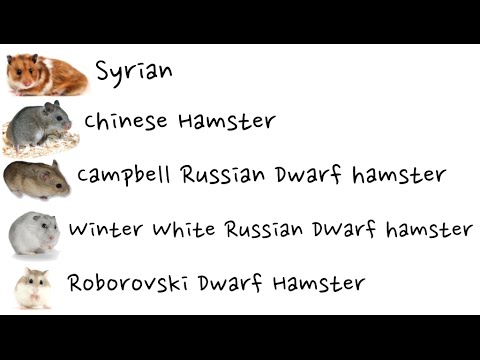Hamster Species Identification
Understanding Different Hamster Species
Identifying various hamster species is essential for any hamster owner or enthusiast. There are several species of hamsters, each with unique characteristics and care needs. The five most common hamster species include the Syrian hamster, Campbell’s dwarf hamster, Winter White dwarf hamster, Roborovski hamster, and Chinese hamster. Understanding these species helps in providing the appropriate environment, diet, and companionship that each hamster requires for a happy and healthy life.
1. Syrian Hamster
The **Syrian hamster**, also known as the golden hamster, is one of the most popular pets among small rodent lovers. Recognizable for their larger size and longish fur, they typically weigh between 5-7 oz as adults and can grow up to 7 inches long. Syrian hamsters are solitary creatures, generally preferring to live alone, which makes them most compatible as single pets. They require spacious enclosures, good ventilation, and ample bedding to burrow. Known for their playful behavior, **Syrian hamsters** are active during twilight or nighttime hours. Owners enjoy their social and curious nature, making interaction and playtime essential.

2. Campbell’s Dwarf Hamster
The **Campbell’s dwarf hamster** is another popular species, notable for its small size, usually between 3.5 to 4.5 inches in length. These energetic little creatures can be delightful companions and can often adapt well to living in small groups if introduced properly at a young age. They have a variety of fur colors, including agouti, gray, and cream. The **Campbell’s dwarf hamster** is known for its playful and sociable traits, making it ideal for families. However, they can be territorial and may need more effort in socializing and introducing new companions to avoid aggressive behaviors.
3. Winter White Dwarf Hamster
Closely related to Campbell’s hamsters, **Winter White dwarf hamsters** have distinct seasonal pelage changes, turning pure white in color during cold months. They range from about 3 to 4 inches in adulthood and are well-mannered companions, thriving in environments with same species companionship. Their gentle nature makes them easier to handle, especially for children. A spacious habitat that allows for adequate exercise and fun is essential, as **Winter White hamsters** are highly active and enjoy running on wheels or through maze toys.
Identifying Hamster Species Differentiating Traits
Differentiating between species can be straightforward once you recognize key traits. For instance, the Syrian hamster is easy to spot due to its larger size and golden fur. In contrast, both types of dwarf hamsters are typically smaller and come in more varied colorations. Observing social behaviors can also offer clues: **Syrian hamsters** are solitary, while the dwarf species might be more adaptable in groups, provided introductions are done delicately. Additionally, hamsters’ fur types vary—with **Syrian hamsters** having longer coats, visible even at a distance.
1. Size Comparison
The most apparent difference in species is their size. **Syrian hamsters** can reach about 7 inches, whereas the dwarf varieties, such as **Campbell’s** and **Winter White**, generally fall between 3 to 4.5 inches. Taking note of these size discrepancies quickly helps in identifying which species you encounter.
2. Fur and Color Variations
Fur texture and coloration serve as excellent identification tools for hamster species. **Syrian hamsters** exhibit a variety of coat colors, typically gold to cream, while Campbell’s and Winter White species come in a broader palette, including gray and even mottled patterns. Additionally, hamsters’ fur characteristics, such as whether they have a long or short coat, can indicate species.
Conclusion: Identifying the Right Hamster Species for You
Understanding **hamster species identification** enables better care and ensures that individuals select the hamster best suited to their living situation and lifestyle. Each species has unique traits that complement various living environments, and identifying these traits is crucial in responsible pet ownership. Ensure you conduct thorough research and breed-specific care practices to provide the best habitat for your furry friends.
FAQ
1. How can I tell if my hamster is a dwarf or a Syrian?
The easiest way to differentiate between a dwarf hamster and a Syrian hamster is through size. **Syrian hamsters** are significantly larger, generally around 7 inches in length, while dwarf species measure around 3–4 inches. Additionally, their fur length varies, with **Syrian hamsters** typically possessing longer fur.
2. Are all dwarf hamsters social with each other?
Not all dwarf hamsters are inherently social. While species like **Campbell’s dwarf hamsters** can coexist in pairs or small groups if socialized properly, others can be territorial. It’s recommended to introduce them at a young age to promote harmony, closely observing their behavior during initial encounters.
3. What type of habitat is best for dwarf hamsters?
Dwarf hamsters thrive in spacious cages or habitats equipped with exercise wheels, tunnels, and hideouts. They require bedding that allows natural burrowing behavior. Ensure the setup accommodates their active lifestyle and provides constructions to facilitate play and exploration.
4. How do I care for a Winter White dwarf hamster?
To care for a **Winter White dwarf hamster**, maintain a clean and spacious environment with social opportunities if introduced to others. Provide a balanced diet of high-quality hamster pellets, fresh fruits, and vegetables, while ensuring access to fresh water. Regular grooming is not necessary but monitor fur for any signs of matting or dirt.
5. Can I keep different hamster species together?
In general, it’s not recommended to keep different hamster species together. **Syrian hamsters** are solitary, while differing dwarf species may be compatible under specific conditions. Mixing species could lead to territorial disputes or aggression. It’s safer to house same-sex groups within the same species.
